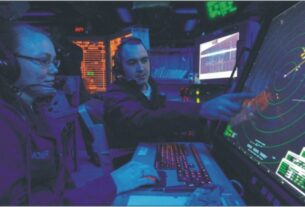Modern military forces cannot succeed in modern battlefield without the secure and unimpeded use of the electromagnetic spectrum. As armed forces the world over are increasingly dependent on electronic assets to perform every aspect of multi-spectrum operations so the vulnerability of these assets are exposed to the growing number and sophistication of air and ground-based threats.
In order to increase survivability and ensure spectrum dominance, troops must be trained effectively and electronic assets must be equipped with proven, effective and integrated EW systems and solutions to defend against these threats; deny the enemy access to the EM spectrum and to disrupt enemy capabilities before they become threats. Even the prowess of electronic warfare system was amply demonstrated by the US armed forces in Iraq and Afghanistan.
As new technologies emerge and new cyber and electronic warfare threats plague soldiers in the field, military commanders, defence scientists and engineers continue to define next-generation protocols and system architectures to help develop technology capabilities to combat these threats in an integrated and expedited fashion.
The boundaries between traditional cyber threats and traditional EW threats have blurred, allowing EW systems to access the data stream to combat EW threats.
Tactical EW systems and sensors provide for significant points of presence on the battlefield, and can be used for cyber situational awareness and as delivery platforms for precision cyber effects to provide a means of Electronic Counter Measures and Electronic Counter-Counter Measures.
The battlefield of electronic warfare is global and its intensity varies according to different national perceptions of potential threats. In fact, electronic warfare is a catalyst towards the maintenance of regional and global balances which deter the outbreak of armed conflict.
Electromagnetic spectrum
Electronic devices dominate modern combat. Warfighters depend on access to the electromagnetic spectrum to communicate with friendly forces, track enemy movements, navigate in the fog of war, collect intelligence, and perform many other vital functions. Electronic warfare is the military specialty concerned with denying enemy forces use of the spectrum while assuring that friendly forces have unfettered access.
Electronic Warfare (EW) is not strictly ‘electronic’, i.e., it is not conducted using electrons; rather it is electromagnetic, and uses the entire range of the electromagnetic spectrum. EW is military action involving the use of electromagnetic energy to determine, exploit, reduce or prevent hostile use of the electromagnetic spectrum and action which retains friendly use of the electromagnetic spectrum. More specifically it is the application of technology, strategy and tactics to deny the opponent the partial or full use of those electronic systems which rely upon the transmission of electromagnetic energy, primarily radar and communications.
Use of electronic systems to detect, intercept and jam the enemy’s radar and communication networks, while preventing hostile forces from doing the same, is part of the rapidly digitizing battlefield these days. In short, the battle is now over achieving control of the entire electromagnetic spectrum during any military action.
Import of EW systems, which consist of electronic support measures, electronic counter measures and electronic counter-counter measures, can prove dangerous since there is always the possibility of their operational capabilities being leaked to an adversary in times of conflict.
The goal of electronic warfare is to control the electromagnetic spectrum. It is generally considered to consist of – electronic attack, electronic protection and electronic support.
Electronic warfare is not new; it has been practiced in one form or another in every major conflict since the early days of this century; in fact, ever since radio communications were first used in war. Early techniques were often primitive and it was only from World War II onwards that EW gained an element of sophistication and maturity.
During the WWI the electronic warfare was mainly limited to listening of enemy communications and sporadic jamming, but during the WWII the EW experienced rapid development.
World War I saw the widespread use of radio for communication and transmission of combat information. In 1914, the Germans intercepted the communication system of the British forces. This communication jamming in practice is considered the first real action of EW, as electromagnetic energy had been used, not for communication, but for jamming enemy communications. It was also during World War I that both sides experimented with electronic deception in its the simplest forms, such as false transmissions, electronic the espionage, dummy traffic and other similar ruses for misleading the enemy.
The first reported conflict involving the use of EW was the Russo-Japanese War of 1905, when Russian naval commanders attempted to jam radio transmissions from Japanese ships. However, in this war, the Japanese were successful in trailing the Russian fleet because they could transmit information about their movements and combat formations, without getting jammed, back to the Japanese high command for necessary action.
Electronic warfare systems can effectively change the flight paths of enemy missiles, misinform enemy administrative and troop control divisions, as well as paralyze entire armies. In effect, electronic warfare denotes a series of well-coordinated operations to destroy or suppress electronic troop control systems and weapons, and to protect similar friendly unit systems.
Countermeasures
Due to this ability of EW equipments, efforts are being given to develop advance countermeasures. Countermeasures include all those means of exploiting an adversary’s activity to determine his intentions or reduce his effectiveness. Countermeasures may be applied against weapons operating over the entire spectrum from acoustic to gamma wave frequencies. Since the most prevalent use of this spectrum for weapons and communications, etc. is in the radio frequency (RF) region, most counter measures and counter-countermeasures also operate in that region.
Countermeasures in the RF region of the electromagnetic spectrum are collectively grouped under an umbrella termed Electronic Warfare (EW). EW has three branches: Electronic Support Measures (ESM), Electronic Countermeasures (ECM), and Electronic Counter-Counter Measures (ECCM).
Electronic countermeasures (ECM) is the active part of EW and is intended to disrupt the surveillance systems of the enemy, whether by radar or radio communications, and also to counter any of his weapons which use electromagnetic, infrared or laser systems for guidance or aiming. There are two main methods of achieving this: by jamming, or by the use of decoys, both of which are effective when used properly. Many modern ECM equipments, particularly in the naval scenario, employ both methods in an integrated system.
Noise jamming is the use of transmissions to disrupt the enemy’s communications channels or to saturate his radar to obscure its target. Although this denies the enemy his information channels it also means that the jamming source cannot read the signals for intelligence purposes. Apart from this, modern frequency-agile communication systems are no longer easy to jam effectively.
Simple noise jamming is still in widespread use in the land warfare scenario, one important application being in remotely operated expendable jammers. These can be hand-emplaced, artillery-delivered, dropped from aircraft or used in unmanned aerial vehicles, and serve as short term jammers for a particular operation.
The second method of ECM is the use of decoys, either chaff in the case of electromagnetic threats or flares to combat infrared devices. The use of chaff goes back over 50 years to the Second World War, and the material itself has changed very little. What has been changed is the method of dispersal and this varies according to the type of platform. For infrared countermeasures flare cartridges are ejected from the dispensers and most dispensers have a dual role of carrying both chaff and flares.
Electronic support measures (ESM) is that division search the RF spectrum for emissions and analyze the results to exploit the weapons or sensors involved. Exploitation includes tactical early warning, identification for counter weapon selection and recording to support countermeasures development.
Electro-optical-infrared countermeasures consist of any device or technique employing electro optical-infrared materials or technology that is intended to impair or counter the effectiveness of enemy activity, particularly with respect to precision guided weapons and sensor systems. Electro-optical-infrared is the part of the electromagnetic spectrum between the high end of the far infrared and the low end of ultraviolet. Electro-optical-infrared countermeasures may use laser and broadband jammers, smokes/aerosols, signature suppressants, decoys, pyrotechnics/
pyrophorics, high-energy lasers, or directed infrared energy countermeasures.
Radio frequency countermeasures consist of any device or technique employing radio frequency materials or technology that is intended to impair the effectiveness of or counter enemy activity, particularly with respect to precision guided weapons and sensor systems.
Support measures
The EW receiver is the primary Electronic Support Measures (ESM) equipment and functions as a sensor for, and as a means of identifying friendly, neutral, and enemy electronic emissions. It provides warning of potential attack, knowledge of enemy capabilities, and an indication of enemy use of active countermeasures to manipulate the electromagnetic spectrum.
Countermeasures are that form of military science that, by the employment of devices or techniques, has as its objective the impairment of the operational effectiveness of enemy activity. They can be deployed preemptively or reactively. Devices and techniques used for EW countermeasures include electro-optical-infrared countermeasures and radio frequency countermeasures.
The types of electromagnetic radiating systems against which ECM may be employed-either sensors or communications systems-enemy sensors receive by far the greatest attention. The primary reasons for this fact are that the enemy sensor system produces an immediate threat, whereas the communications system does not, and the sensor system is usually specifically directed toward the friendly forces, and communications are not.
Two major actions of ECM are jamming and deception. The deliberate radiation, re-radiation, or reflection of electromagnetic energy to impair the use of electronic devices, equipment, or systems is called Jamming. The deliberate radiation, re-radiation, alteration, absorption, or reflection of electromagnetic energy in a manner intended to mislead the enemy in the interpretation or use of information received by his electronic systems is called deception.
The basic purpose of ECM is to interfere with the operation of the sensors of the air or surface defence system, and through them to interfere with the operation of the system itself. Briefly, ECM attempts to make the defense more uncertain as to the threat it faces. The greater the defence uncertainty, the more effective is the ECM. To state this principle another way, ECM attempts to reduce the information content of the signals the defence receives with its sensors. The objective of ECM, then, is to force the air or surface defence system to make mistakes or errors.
The Vietnam War of 1965, which continued up to 1971, clearly demonstrated the conflict between radar and ECM and between ECM and ECCM. The race of developing countermeasures against countermeasures continued to be directed to outmaneuver and outperform the adversary’s equipment and ECM.
There are two major techniques of ECM Active (i.e., radiating) ECM and Passive (i.e., non-radiating) ECM. Further, Active Jamming may be either Noise Jamming or Deceptive Jamming whereas Passive Jamming may be achieved by chemical or mechanical means. Within each class of jamming, there are different techniques used for denial or deceptive purposes.
Active ECM involves degradation of the effectiveness of the enemy system by generating an transmitting electromagnetic energy .This may be achieved either by noise jamming or by deceptive jamming. Passive ECM involves deception of enemy’s system by employing confusion reflectors. This may be achieved either by chemical or mechanical means. This type of jamming is also sometimes called ‘Expendable Countermeasures’ (means an ECM device which is used up in its employment). Chaff and flares are the important examples. In its broadest sense, it not only uses the expendable passive ECM devices but also expendable active devices. These latter devices may be either jammers or deceivers, depending upon the particular effect desired.
Remotely Operated Vehicles (RPVs), drones and special projectiles containing chaff, flares or jamming equipment are also widely used to deceive the enemy. The jamming equipment may consist of simple jammers, radar signal repeaters, deception jammers or systems which simulate the target’s electromagnetic signature.
Modern ECM systems are designed to detect, classify, and identify hostile radar threats, and to direct timely jamming responses automatically against threats on a priority basis. A modern ECM system is intended to counter surface-to-air missiles, anti-aircraft guns, and air-to-air missile fire control radars, and to degrade, by noise jamming, early-warning and ground-controlled intercept radars.
The philosophy of ECM against communications emitters is somewhat different than that against radars. A major reason for this is that intercepted communications traffic becomes a major intelligence source for the commander. Also, the density and methods of operating tactical radios, particularly the netting, is different from radar. The essential ingredient of communications jamming is radio direction-finding. Once a tactical communication emitter is located, there are three options open to battlefield commanders. These are: physical destruction, intelligence exploitation, or electronic jamming.
Electronic counter-countermeasures (ECCM), another critical component of modern EW scenario is defined as actions taken to ensure friendly use of the electromagnetic spectrum against an EW threat. Thus ECCM is the art of reducing the effectiveness of an EW threat so that the cost of effective EW becomes prohibitive for the enemy.
There is one fundamental difference between ECCM and ECM. ECCM is mostly concerned with techniques which are embodied in the design of electronic equipment (e.g., radar and its constituent parts like receiver, transmitter, etc.) while ECM usually requires a separate item or unit of equipment which operates in its own right and not as an adjunct to another system.
Electronic warfare is much more developed than most other areas of information security. There are many lessons to be learned, from the technical level up through the tactical level to matters of planning and strategy. One can expect that, as information warfare evolves from a fashionable concept to established doctrine, these lessons will become important for practitioners.





